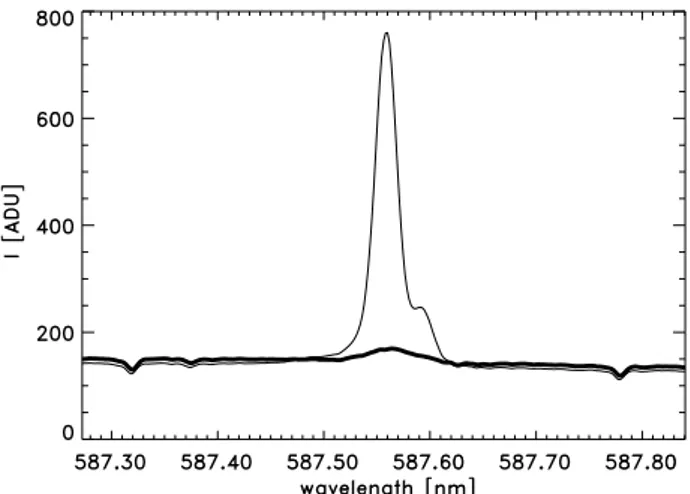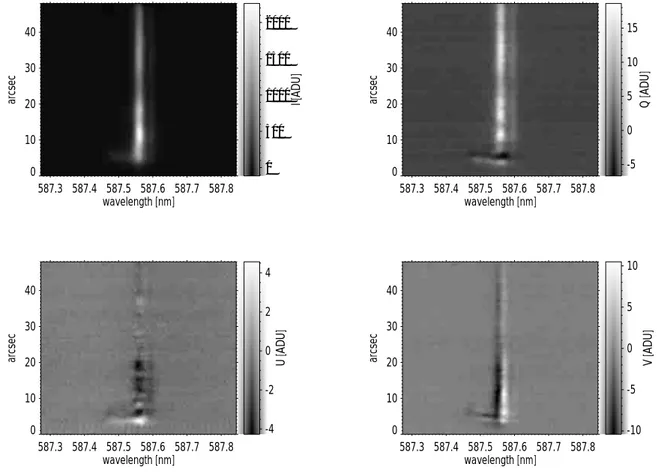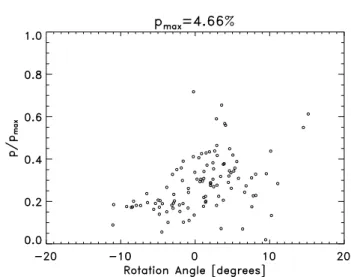HAL Id: hal-02393072
https://hal.archives-ouvertes.fr/hal-02393072
Submitted on 24 Jan 2021HAL is a multi-disciplinary open access
archive for the deposit and dissemination of sci-entific research documents, whether they are pub-lished or not. The documents may come from teaching and research institutions in France or abroad, or from public or private research centers.
L’archive ouverte pluridisciplinaire HAL, est destinée au dépôt et à la diffusion de documents scientifiques de niveau recherche, publiés ou non, émanant des établissements d’enseignement et de recherche français ou étrangers, des laboratoires publics ou privés.
Full-Stokes spectropolarimetry of solar prominences
F. Paletou, A. Lopez Ariste, V. Bommier, M. Semel
To cite this version:
F. Paletou, A. Lopez Ariste, V. Bommier, M. Semel. Full-Stokes spectropolarimetry of solar promi-nences. Astronomy and Astrophysics - A&A, EDP Sciences, 2001, 375 (3), pp.L39-L42. �10.1051/0004-6361:20010927�. �hal-02393072�
DOI: 10.1051/0004-6361:20010927 c
ESO 2001
Astrophysics
&
Full–Stokes spectropolarimetry of solar prominences
?
F. Paletou1, A. L´opez Ariste2, V. Bommier3, and M. Semel4
1
Observatoire de la Cˆote d’Azur, D´epartement G. D. Cassini, BP 4229, 06304 Nice Cedex 4, France 2 High Altitude Observatory, NCAR??, PO Box 3000, Boulder CO 80303, USA
e-mail: alopez@hao.ucar.edu
3 Observatoire de Paris, DAMAp (CNRS/UMR 8588), 92195 Meudon, France e-mail: v.bommier@obspm.fr
4 Observatoire de Paris, DASOP–LPSH (CNRS/UMR 8645), 92195 Meudon, France e-mail: meir.semel@obspm.fr
Received 18 June 2001 / Accepted 28 June 2001
Abstract. We report on first spectropolarimetric observations of solar prominences made at THEMIS. Hereafter
we shall emphasis on the preliminary analysis of He i D3 full-Stokes observations. Our measurements clearly show manifestations of both the Hanle and Zeeman effects. More generally, we demonstrate the very favourable performances of the THEMIS multi-line spectropolarimetric mode for further new investigations of the magnetic field in solar prominences.
Key words. Sun: prominences – Sun: magnetic fields – polarization
1. Introduction
Quoting Einar Tandberg-Hanssen (1974), “the single,
physically most important parameter to study in promi-nences may be the magnetic field. Shapes, motions, and in fact the very existence of prominences depend on the nature of the magnetic field threading the prominence plasma”. Indeed, being low β structures, the channeling of
plasma motions and of thermal conduction are controlled by the magnetic field, and it provides also support to the prominence material against gravity (D´emoulin 1998). Details and further references can be found in the reviews of Leroy (1989) and Landi Degl’Innocenti (1990), as well as in Tandberg-Hanssen (1974, 1995).
Polarimetry constitutes a unique tool for the direct measurement of astrophysical magnetic fields. Up to now, the most comprehensive observational work on the deter-mination of magnetic fields in solar prominences was led by J. L. Leroy using the facilities of the Pic du Midi ob-servatory (France). First measurements, using the D3line of He i, were done in 1973–1976 with a photo-electric polarimeter attached to a 26 cm diameter coronograph
Send offprint requests to: F. Paletou,
e-mail: paletou@obs-nice.fr
? Based on observations made at THEMIS, operated on the
Island of Tenerife by CNRS–CNR in the Spanish Observatorio
del Teide of the Instituto de Astrof´ısica de Canarias.
?? The National Center for Atmospheric Research (NCAR) is
sponsored by the National Science Foundation.
(Leroy et al. 1977; Leroy 1977, 1978). This instrumenta-tion offered a rather high polarimetric sensitivity (better than 10−3) at the price of a poor spatial resolution (∼300) and, no spectral resolution. However, the measured linear polarization signals could be interpreted further in terms of magnetic field strength and orientation by use of the Hanle effect theory (Sahal-Br´echot et al. 1977; Bommier & Sahal-Br´echot 1978).
Shortly after, Bommier et al. (1981) pointed-out the possibility of a complete determination of the prominence magnetic field from two simultaneous (linear) polarization measurements made at two different wavelengths. One so-lution is indeed to observe two different spectral lines, such as D3 and the Hα or Hβ Balmer lines of H i, for instance. This approach was successfully applied to diag-nose new data taken during the 1974–1982 period (Leroy et al. 1983, 1984).
Another possibility comes from the use of the two com-ponents of D3 itself, namely the 3d3D3,2,1→ 2p3P1,2and 3d3D
1→ 2p3P0 groups of atomic transitions. However it requires to spectrally resolve those two components dis-tant of some 34 pm. First profiles of the D3line observed in solar prominences were recorded in September 1977 with the HAO Stokes polarimeter available at the 40 cm corono-graph of the NSO Evans Solar Facility at Sacramento Peak (Baur et al. 1981). Those new measurements allowed for a complete determination of the magnetic fields in quies-cent prominences (Landi Degl’Innoquies-centi 1982; Athay et al. 1983; Querfeld et al. 1985).
L40 F. Paletou et al.: Full–Stokes spectropolarimetry of solar prominences It was then well assessed from all these works that
the mean magnetic field in quiescent prominences (i) has strength in the 3–15 G range, (ii) it is almost horizontal and (iii) it makes a small angle (∼25◦) with the long axis of the structure. However, after the success of the 70’s and 80’s, and besides quite recent observations of filaments (i.e. a prominence as seen on projection against the solar disk) made in the 1083 nm line of He i by Lin et al. (1998), there has been up to now just very little “activity” in the field of the spectropolarimetry of solar prominences. On the other hand, nowadays instruments provide higher spatial and spectral resolution observations together with a∼10−3 (or better) polarimetric sensitivity.
THEMIS allows for multi-line spectropolarimetric ob-servations at high resolution in the visible, which is def-initely critical in order to perform a reliable diagnosis of prominences magnetic fields. The photon collector is large: the primary mirror’s diameter is 90 cm, and it was super-polished at REOSC down to a 4 ˚A roughness (P. Assus, private communication). In combination with a unique multi-line capability, full-Stokes spectropolarimetry gives an opportunity to carry out new observations with the aim of improving our knowledge of the prominences magnetic field.
2. Observations and data reduction
A 7-days observing run dedicated to the full-Stokes spec-tropolarimetry of limb prominences in the He i D3 and H i Hα spectral lines simultaneously, was conducted in June 2000. We used the multi-line spectropolarimetric (MTR) observing mode available at THEMIS. The latter has been described in some details by Paletou & Molodij (2001).
2.1. Observational procedure
We shall focus on observations made on June 15th, 2000 between 07:18 and 09:40 UT. We selected a low-lying and rather bright prominence passing at the South-Western limb, at a polar angle of ∼246◦. Synoptic ob-servations made during the previous days showed that the filament long-axis was oriented∼45◦respective to the local meridian. Our observations were made in a sit-and-stare mode, with the slit oriented parallel to the near-est limb, and at some 3000 above the limb. We recorded a total of 4× 50 images in a row, according to the fol-lowing temporal sequence for the polarization analysis: [(I± U), (I ∓ Q), (I ∓ U), (I ∓ V )] (a calcite beam-splitter was used; therefore the 2 orthogonal states of polariza-tion were measured simultaneously). This took us 31 min with an exposure time of 8 s per image. The scintillome-ter’s real-time measurement available at THEMIS indi-cated a very stable and excellent seeing, of the order of 0.500, during the whole observing sequence.
At the time of the observation, the sky’s transparency was also quite good for the site. In order to evaluate the amount of diffused light contaminating the prominence
Fig. 1. The mean D3emission profile is displayed before having corrected it for diffused light. The thick line (slightly shifted in intensity for comparison) represents the spectral variations of the latter quantity as derived from our observations.
emission spectra, we recorded a set of images with the slit put off–limb at a neighbouring radial position, although at the same radial distance and with the same relative orientation vs. the nearest limb as in the prominence case. The level of diffused light as compared to the overall signal is shown in Fig. 1. Spectral variations are small but not negligible. A faint chromospheric D3 emission component can be seen. At both ends of the spectral window, small absorption features can be clearly noticed, corresponding to photospheric Fe lines. No significant polarization signal was found from this set of images.
2.2. Data reduction
We adopted the numerical procedure first proposed by Trujillo Bueno et al. (2001). We could therefore retrieve a full Stokes vector with a temporal cadence of ∼37 s. Indeed, after each set of four successive independent mea-surements, a Stokes vector can be computed by inverting, for each beam, the “modulation” scheme which we may formally write as:
(I± U) (I∓ Q) (I∓ U) (I∓ V ) = 1 0 ±1 0 1 ∓1 0 0 1 0 ∓1 0 1 0 0 ∓1 I± Q± U± V± , (1)
and finally, recombine the two beams by a simple averag-ing (σ = 12(σ++ σ−), with σ = I, Q, U, V respectively). Our naming convention for the linear polarization Stokes parameters Q and U agrees with the usual reference for which the direction of positive Q is parallel to the limb.
It is important to bear in mind that, as written above, the modulation scheme implicitly considers perfect re-tarders. On the contrary, the quarter-wave plates we used show some phase chromatism in the 400–700 nm range; they depart from being λ/4 by roughly +3◦ at 587.6 nm. However, one can easily extend the above-described re-duction scheme in order to take into account for phase
0 500 1000 1500 2000 I [ADU] 587.3 587.4 587.5 587.6 587.7 587.8 wavelength [nm] 0 10 20 30 40 arcsec -5 0 5 10 15 Q [ADU] 587.3 587.4 587.5 587.6 587.7 587.8 wavelength [nm] 0 10 20 30 40 arcsec -4 -2 0 2 4 U [ADU] 587.3 587.4 587.5 587.6 587.7 587.8 wavelength [nm] 0 10 20 30 40 arcsec -10 -5 0 5 10 V [ADU] 587.3 587.4 587.5 587.6 587.7 587.8 wavelength [nm] 0 10 20 30 40 arcsec
Fig. 2. Maps of the time-averaged Stokes parameters I, Q, U and V .
chromatism, and therefore accurately consider crosstalks among the measured Stokes parameters.
Application of this procedure shows that U could be determined with a 1.25×10−3polarimetric sensitivity per pixel, and twice as much for Q and V , in agreement with previous estimates of L´opez Ariste et al. (2000). This can be improved by a factor of√50 by avering the images of the full temporal sequence in time, while keeping intact the spatial–spectral multiplex on the CCD images.
3. First results and discussion
One can clearly see in Fig. 2 a very nice Q signal, persisting along most of the slit i.e. over a field of view of ∼5000. The contribution of both “components” of the D3line are detected, although the red component is indeed weaker and more affected by the noise level; typical values are of the order of Q/Imax = 0.7% for the blue component, while it goes down at the 0.2% level for the red one. Spatial variations along the slit are also noticeable.
Stokes U ∼ 0 at most of the upper part of the slit. This would agree with transverse magnetic field lines, as long as the field strength does not exceed a few tens of Gauss. However, examination of the lower half of the field of view reveals patches of small amplitude U signals at the−0.2% level. These are signatures of a rotation of the plane of polarization such as predicted by the Hanle effet, i.e. a modification of non-magnetic resonance polarization
induced by the presence of magnetic field lines having line-of-sight components.
Our measurements of both Q and U Stokes param-eters can be spectrally integrated giving mean values ¯Q
and ¯U at different spatial positions along the slit. Then,
following previous works done by Leroy’s group, a linear polarization rate can be derived:
p = p ¯ Q2+ ¯U2 ¯ I · (2)
This obviously need a very careful correction of the dif-fused light in order to avoid spurious estimates of the in-tegrated line intensity ¯I.
Afterwards, we can compute the linear polarization di-rection which is given by:
θ = 1 2arctan ¯ U ¯ Q· (3)
Polarization diagrams of p vs. θ can be built in order to inverse the data. More precisely, the rate of linear polariza-tion was normalized to an upper limit value, pmax, which correponds to the maximum rate which would have been obtained in the absence of magnetic field. For this height above the limb, pmax= 4.66% (Leroy et al. 1977).
Points in Fig. 3 with the largest p/pmax values denote magnetic field strengths typical for quiescent prominences (say, up to 15 G), according to polarization diagrams pub-lished earlier (e.g. Sahal-Br´echot et al. 1977). However,
L42 F. Paletou et al.: Full–Stokes spectropolarimetry of solar prominences
Fig. 3. Polarization diagram using the spectrally integrated
linear polarization measurements. Clear Hanle depolarizations are seen together with several points revealing a rotation of the plane of polarization.
lower values of p/pmax are consistent with larger field strengths. From our polarization diagram, we can there-fore conclude that we detected variations of the strength and orientation of B within the∼5000of our field of view. However, the most striking feature in these observa-tions may very likely come from the Stokes V image in Fig. 2. Indeed, although very small signals appear along most of the upper half of the field of view, very conspic-uous Zeeman-like signals are detected in the lower half of the field of view. This clearly proves the presence of rather large magnetic field values, and again its change in strength and orientation within the prominence body. Figure 4 shows a typical example of the agreement be-tween Stokes V and ∂I/∂λ at a given slit location. Indeed, according to the classical relationship for the Zeeman effect:
V ∝ 4.67 × 10−13λ20(˚A)geffBlos(G)
∂I
∂λ, (4)
we can easily evaluate large magnetic field values in what seems to be an “active lobe” in the prominence (this is also suggested by the presence of large velocity fields). Values in the 30–45 G range are found.
4. Conclusion
THEMIS proves to be a suitable instrument for the ob-servation of cool coronal structures such as prominences. Our preliminary full-Stokes observations in the He i D3 spectral line showed clear variations in strength and ori-entation of the prominence magnetic field.
New measurements are expected to bring new light on the study of the inhomogeneity of the magnetic field, and its relationship with the well-known fine structure of the prominences. Temporal variations will also be studied in more details.
Acknowledgements. Our warmest thanks go to J. L. Leroy for
his advices and kind encouragements.
Fig. 4. Example of one of the Stokes V profiles as compared to
the re-scaled derivative of I displayed as the thick curve. This corresponds to a line-of-sight magnetic field of 42 G.
References
Athay, R. G., Querfeld, C. W., Smartt, R. N., Landi Degl’Innocenti, E., & Bommier, V. 1983, Sol. Phys., 89, 3 Baur, T. G., Elmore, D. E., Lee, R. H., Querfeld, C. W., &
Rogers, S. R. 1981, Sol. Phys., 70, 395
Bommier, V., Leroy, J. L., & Sahal-Br´echot, S. 1981, A&A, 100, 231
Bommier, V., & Sahal-Br´echot, S. 1978, A&A, 69, 57 D´emoulin, P. 1989, in New Perspectives on Solar Prominences,
IAU Colloq. 167, ed. D. Webb, D. Rust, & B. Schmieder, ASP Conf. Ser., 150, 78
Landi Degl’Innocenti, E. 1982, Sol. Phys., 79, 291
Landi Degl’Innocenti, E. 1990, in Dynamics of Quiescent Prominences, IAU Colloq. 117, ed. V. Ruˇzdjak, & E. Tandberg-Hanssen (Springer)
Leroy, J. L. 1977, A&A, 60, 79 Leroy, J. L. 1978, A&A, 64, 247
Leroy, J. L. 1989, in Dynamics and Structure of Quiescent Solar Prominences, ed. E. R. Priest (Kluwer)
Leroy, J. L., Bommier, V., & Sahal-Br´echot, S. 1983, Sol. Phys., 83, 135
Leroy, J. L., Bommier, V., & Sahal-Br´echot, S. 1984, A&A, 131, 33
Leroy, J. L., Ratier, G., & Bommier, V. 1977, A&A, 54, 811 Lin, H., Penn, M. J., & Kuhn, J. R. 1998, ApJ, 493, 978 L´opez Ariste, A., Rayrole, J., & Semel, M. 2000, A&AS,
142, 137
Paletou, F., & Molodij, G. 2001, in Advanced Solar Polarimet-ry, ed. M. Sigwarth, ASP Conf. Ser., 236, in press
Querfeld, C. W., Smartt, R. N., Bommier, V., Landi Degl’Innocenti, E., & House, L. L. 1985, Sol. Phys., 96, 277 Sahal-Br´echot, S., Bommier, V., & Leroy, J. L. 1977, A&A,
59, 223
Tandberg-Hanssen, E. 1974, Solar Prominences (Reidel) Tandberg-Hanssen, E. 1995, The Nature of Solar Prominences
(Kluwer)
Trujillo Bueno, J., Collados, M., Paletou, F., & Molodij, G. 2001, in Advanced Solar Polarimetry, ed. M. Sigwarth, ASP Conf. Ser., 236, in press


